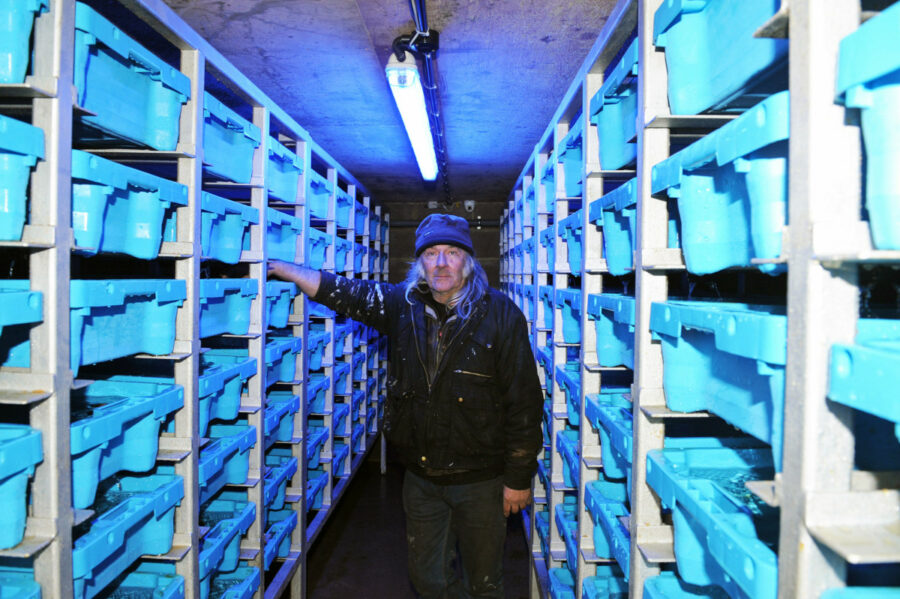Joint-funded by the Blue Marine Foundation and Dorset and East Devon FLAG, a new storage facility for live lobsters will soon be in operation at Axmouth harbour in East Devon.
Phil Lockley reports
Officially opened on 14 January, the lobster storage facility is capable of holding around 500kg of lobsters. Developments of markets direct from ‘pot to plate’ will be encouraged, explained inshore skipper Angus Walker, who has been pivotal in a series of improvements to the harbour and is the serving assistant harbour master and leader of East Devon Fishermen’s Association (EDFA).

Angus Walker, serving assistant Axmouth harbour master, was instrumental in the port’s new lobster store project. He and members of the East Devon Fishermen’s Association carried out a great deal of the work.
He said: “Together with the port’s ice machine, cold room facilities, harbour davit and more, the lobster storage plant is a further step towards making the adjacent towns of Axmouth and Seaton a vibrant region in the West Country fishing industry.”
Built by tradesmen and members of the EDFA, the lobster storage facility is not a move to avoid sales through shellfish merchants, he explained, but ‘to even out sales and better protect our fishermen when the prices drop’. He added: “We will be one step further down the chain from catching the lobster to reaching its consumer, and equally, one step higher in the profits made.
“Geographically, we are just inside the region for Dorset and East Devon FLAG funding, which provided 60% of the total cost, which was just short of £42,000. The Blue Marine Foundation provided the remaining 40%.”
As facilitator of the Lyme Bay Fisheries and Conservation Reserve – a region of 90 square miles protected from towed gear, conserving local stocks for future generations of fishermen – the Blue Marine Foundation continues to support controlled fishing.
Angus Walker continued: “The project is another step in ongoing investments to support our fishing industry, and with the help of East Devon District Council, over the years we’ve been able to deliver six large projects to make this port special. One of the first projects was to put a modern road bridge between Seaton and Axmouth. A dock crane at Axmouth harbour was fitted, and not long ago, with the help of the Blue Marine Foundation, we were able to install an ice-making facility and a cold store.
“It has been an extraordinary experience getting all of these projects in place to support a relatively small fleet of 18 working boats. Collectively, the harbour has been transformed, and through the EDFA, some improvements have come from direct investments made by Axmouth fishermen. For example, the whole harbour now has CCTV and floodlights, both of which we installed and run. Over the last four years, thefts and/or damage to fishing gear have been almost wiped out – so far, there has been just one incident in that time.
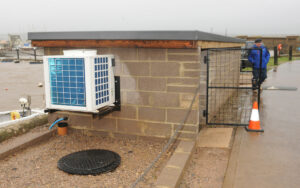
Beneath the black cover is the main seawater reservoir, which has a capacity of 15,000 litres. Above is the central unit of the bio-filtration system.
“The lobster storage facility also provides added safety for the fishermen. Effectively, by using the store they have no need to use store pots; the shores along East Devon and West Dorset can be subject to dreadful weather, and using store pots often leads to considerable loss in returns.
“Of the 18 registered fishing boats at Axmouth, around half are predominantly shellfish boats, but other fishermen specialise in line fishing for species like bass. We also have a couple of netters that specialise in other species, so we have a diverse fleet.”
Martin Sutcliffe, Dorset and East Devon Fisheries Local Action Group (FLAG) co-ordinator, said: “Angus Walker has been instrumental in this project, and without his drive and commitment, it may not have happened. That is the same for other projects – his drive to better the port is huge.
“The FLAG has been involved in many projects at Axmouth harbour, and the lobster storage facility is another layer of those projects. Other layers include solar panels, giving cheaper power to enable those fishermen to run the lobster store.”
Martin Sutcliffe is not new to the concept of healthy storage of marine life – his duties prior to joining the FLAG included 10 years working for Sea Life, a chain of commercial sea-life aquarium attractions.
Lobster store uses technology from around the world
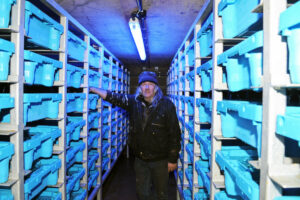
Angus Walker demonstrates the workings of the storage system, which is capable of holding 500kg of lobsters. The blue lighting system is ‘far better for the lobsters than daylight’, he said.
Studies of the best methods for holding live seafood from around the world were used to deliver a bio-filtered storage system capable of holding 500kg of lobsters, said skipper Angus Walker.
He explained how a plastic seawater tank with a capacity of 15,000 litres was lowered and secured into the harbour wall below the water level at low tide. A ceramic-built, solid-state controlled pump, able to circulate 17,000 litres per hour, drives the system.
“During operation, the tank is only two-thirds full, while a steady flow of seawater is led to a pod system of cages – units holding a total of 140 tanks.
“On the internet, I read 36 different dissertations – from keeping crayfish in New Zealand, to methods used at science laboratories at Woods Hole in Massachusetts in the USA. I also studied systems used at places in Scotland and, of course, at the National Lobster Hatchery at Padstow in Cornwall.
“Apparently, seawater absorbs oxygen better on a temperature scale from 5°C to 10°C – a span where the metabolism of lobsters is at its least. So in Britain at most times, chilling the seawater to that level is a challenge, and we have fitted three chilling machines to do that. Advice on the number of chillers required came from America, and subsequently we have found that such advice was spot-on.
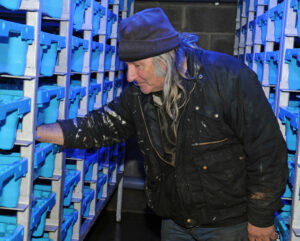
A total of 140 tanks are fed with chilled seawater that passes continually through a bio-filtration system. The flow system and tanks have a failsafe system to ensure lobsters can be kept alive if a power failure occurs.
“The units are in fact chiller/heaters, and should we get very cold conditions, those units warm the seawater to stay within the chosen temperature range.
“We can exchange the seawater when necessary, but with a bio-filtration system, the need to regularly exchange seawater isn’t an issue. Perhaps a partial change may be carried out when the opportunity arises, but the system is totally enclosed and the seawater inside the system can last for a considerable time.
“In Axmouth, having an enclosed system is essential because of a considerable down-flow of freshwater from the river Axe. All aspects of the system – power supply, salinity, flow rate and temperature – have failsafe mechanisms, so the chances of fatalities among the lobsters are very remote.
“If the power supply fails and pumping stops, each tank will have a water level sufficient to keep the lobsters semi-submerged, and enable them to live without harm for a considerable time.
“We have fitted a bio-filtration system – an ingenious system where the seawater leaves the pod system and flows into a 250-litre container holding scallop shells, scrubbed clean and then crushed.
“At first, before the operation of lobster storage begins, the enclosed seawater is pumped to a level covering the shells. The right species of bacteria is then fed into the container – we have simply poured in a sample of seawater obtained from an unfiltered lobster tank at a local fish shop. It contains bacteria ready to digest any faeces and/or other waste from the lobsters. The pump is then switched on, and once up and running, the bio-filtration is self-cultured; any waste that the lobsters produce, those bacteria will digest it. They will then reproduce, and a balanced number of bacteria will remain.

An enclosed pumping system for the storage facility is adjacent to the main storage compartment.
“By having failsafes and a very efficient pumping and filtration system, we will be able to deliver a quality product. Perhaps, at the start of the lobster season, we might have teething problems, but I hope that with the research that we carried out, we have engineered those teething problems into the build, and if any such problems arise, they will be at the lowest level.
“An increasing number of organisations have already shown interest in our lobster storage unit. Scientists from Plymouth University have been there from the start, and we welcome that.”
Blue Marine Foundation SUPPORTS sustainable fishing
Underpinning 40% of the total cost of the Axmouth live lobster storage facility, the Blue Marine Foundation continues its support of sustainable fishing within the Lyme Bay marine protected area (MPA).
The Blue Marine Foundation (BLUE), a registered charity with its headquarters in London, is an organisation that highlights regions of the world where overfishing can permanently denude the seas of valuable marine life. Several BLUE projects promote the future for sustainable fishing, among them the Axmouth live lobster store.
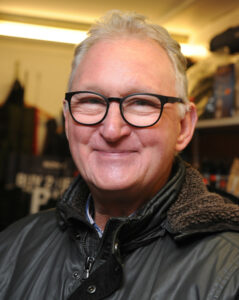
Tim Glover, UK projects director of BLUE.
It says: “Lyme Bay is a BLUE flagship project, proving that sustainable fishing can coexist with conservation. It is one of the largest marine protected areas in the UK – protected from dredging and trawling – preserving rocky reefs and the largest colony of pink sea fan corals in the British Isles. The collaborative model, initiated in 2012 by BLUE and local fishermen, has worked to manage the remaining small-scale, static-gear fisheries within sustainable limits.
“In 2019, BLUE published a pioneering four-year study showing the impact of pot fishing within MPAs. The study, undertaken with Plymouth University and funded by DEFRA, monitored the effect of potting on Lyme’s reefs and the fishermen’s catch. It showed that the number of pots used by fishermen under a voluntary code of conduct had little impact on the marine environment. However, if commercial intensity were to increase above a measurable threshold, the study revealed that the reef species that had started to return could be negatively affected.
“BLUE also created the Reserve Seafood brand to provide new routes to market, with a regular van taking fish to Plymouth. To support this, fishermen carry vessel trackers that guarantee the traceability of each catch.
“The Lyme Bay model on conservation continues to provide a gold standard for the management of marine protected areas, delivering benefits to marine life and the communities that depend on it.”
Tim Glover, the UK projects director of BLUE, told Fishing News: “Conceived in 2011, the Lyme Bay reserve project was our first such project. Axmouth is one of four fishing ports in the reserve, and supporting the building of a lobster store is a natural conservation progression, in that it will prevent the unnecessary mortality experienced with the old method of risky storage at sea. Fishermen will also be able to optimise income by deciding when to take lobsters to market, thereby helping to keep important artisanal fishing communities alive and thriving.

Left to right: Martin Sutcliffe, Dorset and East Devon FLAG co-ordinator, Angus Walker, and Tim Glover, UK projects director of BLUE.
“Where scalloping and trawling are now forbidden across the MPA, we have stepped in to help the static-gear fishermen create and manage a sustainable fishery. All scientific evidence received so far is that collectively, we have achieved that aim.
“At the beginning of the Lyme Bay marine reserve project, we obtained financial backing from Marks & Spencer. We were also provided with funding for a potting study by DEFRA, which was very keen on results being applicable around the coast. The study had collaboration from the fishermen – and that is a rare combination of interests.
“At our quarterly committee meetings for the Lyme Bay Fisheries and Conservation Reserve, we have representative fishermen from all ports, officers from the two IFCAs, Natural England, the MMO, Dorset Wildlife Trust, scientists from Plymouth University, local councillors and others – so you have a whole raft of people who come together, and that is a very unique thing in marine management.
“As an unforeseen consequence of the towed gear ban in 2008, because a great deal of the risk of losing static gear had been removed, the whole area became infested with pots and nets, so what previously – from scalloping and trawling – had been a bad situation for sea life and the bay’s coral reefs in general, became worse for shellfish stocks, putting the future livelihoods of local fishermen at risk.
“So BLUE came in and formed a group with the fishermen, put in voluntary measures, with bottom-up management from the fishermen, and installed a limit on the number of pots being used, and the types of pots being used – whelk, lobsters and crab. The use, lengths and mesh sizes of nets were also controlled voluntarily; all sorts of measures were agreed and adhered to under voluntary codes of conduct.
“The fishermen and other stakeholders have worked tirelessly in support of low-impact fishing and best-practice fishery management, and we think we now have a sustainable fishery, which BLUE is using as a model for collaborative management in other parts of the UK and overseas.”
Angus Walker said: “Being a conservation group, the Blue Marine Foundation realised that small-scale coastal fishermen are an endangered species, and also realised that there is very little it can do within such fisheries if it doesn’t have the consent of those fishermen. Starting from that premise, we now have a relationship with the Blue Marine Foundation that works most of the time, and within that organisation, we have leading people who have expertise from around the world.
“The Lyme Bay initiative model is unique, and you wouldn’t have to go very far around the coast before it wouldn’t or couldn’t work – but the general principle that together with the Blue Marine Foundation, we, the fishermen of Axmouth, have carved out a sustainable fishery, is one that may be transplanted to more places around the UK.
“Without doubt, such moves and joint effort are the way that the politics of fishing and the environment are, at present, going. Inshore fishing is very important in all respects, and politicians realise that. Until now, inshore fishing around the UK has been badly run – both by UK governments and the EU. We now have very dubious regulations smothering the British inshore fishing industry, and with the opportunities available from Brexit, we want that to change.”

